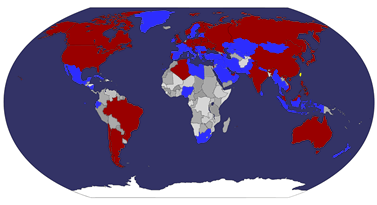90th Anniversary of March 1 Popular Uprising/
90ème Anniversaire du 1 mars Insurrection Populaire
 The March First Movement, or Samil Movement,
The March First Movement, or Samil Movement, was one of the earliest displays of Korean independence movements during the Japanese rule of Korea. The name refers to an event that occurred on 1 March 1919, hence the movement's name, literally meaning "Three-One Movement" in Korean. It is also sometimes referred to as the Manse Demonstrations (만세운동). During the series of demonstrations that began that day and spread throughout Korea, 7,000 people were killed by Japanese police and soldiers.
At 2 P.M. on the 1 March 1919, the 33 nationalists who formed the core of the Samil Movement convened at Taehwagwan Restaurant in Seoul, and read the Korean Declaration of Independence that had been drawn up by the historian/writer Choe Nam-seon and the poet/Buddhist monk Manhae (also known as Han Yongun). The nationalists initially planned to assemble at Tapgol Park in downtown Seoul, but they chose a more private location out of fear that the gathering might turn into a riot. The leaders of the movement signed the document and sent a copy to the Japanese Governor General, with their compliments.
"We herewith proclaim the independence of Korea and the liberty of the Korean people. We tell it to the world in witness of the equality of all nations and we pass it on to our posterity as their inherent right.
We make this proclamation, having back of us 5,000 year of history, and 20,000,000 of a united loyal people. We take this step to insure to our children for all time to come, personal liberty in accord with the awakening consciousness of this new era. This is the clear leading of God, the moving principle of the present age, the whole human race's just claim. It is something that cannot be stamped out, or stifled, or gagged, or suppressed by any means."
They then telephoned the central police station to inform them of their actions and were arrested afterwards.
Despite the nationalists' concerns, massive crowds assembled in the Pagoda Park to hear a student, Chung Jae-yong, read the declaration publicly. Afterwards, the gathering formed into a procession, which the Japanese police attempted to suppress.
Coinciding with these events, special delegates associated with the movement also read copies of the independence proclamation from appointed places throughout the country at 2 PM on that same day, but the nationwide uprisings that resulted were also brutally put down by the Japanese police and army.
Protests nevertheless continued to spread, and as the Japanese national and military police could not contain the crowds, the army and even the navy were also called in. There were several reports of atrocities. In one notable instance, Japanese police in the village of Jeam-ri herded male protesters into a church, locked it, and burned it to the ground.
Approximately 2,000,000 Koreans had participated in the more than 1,500 demonstrations, many who have been massacred by the Japanese police force and army.
According to the frequently referenced The Bloody History of the Korean Independence Movement (한국독립운동지혈사, 韓國獨立運動之血史) by Park Eunsik, 7,509 were killed, 15,849 were wounded, and 46,303 were arrested. During March 1 to April 11, Japanese officials reported that 553 people were killed with over 12,000 arrested, while 8 policemen and military policemen were killed and 158 were wounded.
Many of those arrested were taken to the infamous Seodaemun Prison in Seoul where they were imprisoned without trial and tortured. Several hundred people were murdered in extrajudicial killings in the "death house" at the rear of the site.
In 1920, the Battle of Chingshanli broke out in Manchuria between exiled Korean nationalists and the Japanese Army.
Samiljeol (hangeul : 삼일절), le 1er mars, est le jour du mouvement d'indépendance en Corée.Jour férié en Corée du Sud, il commémore le soulèvement de 1919 contre l'occupation japonaise, après la mort de l'ancien roi Kojong soupçonné d'avoir été empoisonné par les Japonais.Deux jours avant l'enterrement de Kojong, une déclaration d'indépendance a été lue dans le parc de la Pagode, à Séoul. Les écoles et les universités furent fermées. Une jeune femme de quinze ans, Yu Kwan-sun, prit la tête des manifestations. Arrêtée et torturée, elle mourut en prison en 1920, devenant un symbole de la résistance coréenne.La répression aurait causé 7 000 morts et 40 000 arrestations.D'autres futures personnalités coréennes, comme le cinéaste Na Un-gyu, participèrent également au soulèvement du 1er mars 1919. La biographie du président nord-coréen Kim Il-sung souligne que le soulèvement du 1er mars 1919 l'a pour la première fois sensibilisé à la cause de l'indépendance de la Corée.













































.png)




















 taiwan
taiwan  cover or postcard
cover or postcard  FDC
FDC 





























































































